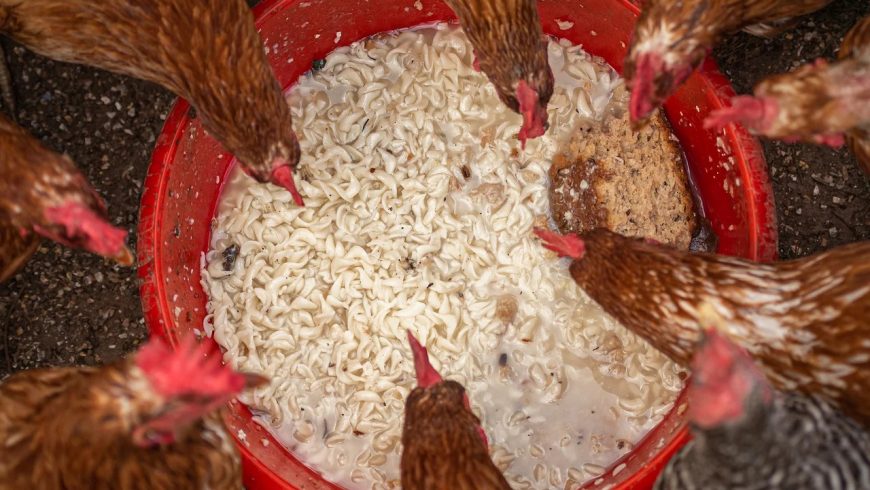D. Choudhury
PhD Scholar, Department of Poultry Science,
Email ID: dimpidear19@gmail.com
College of Veterinary Science, AAU, Khanapara, Guwahati, Assam
INTRODUCTION
Supply of good quality feed to birds is the utmost requirement in poultry industry. It ensures maintenance of overall health of the birds and also reflects over its production performance. Unlike the quality of the feed, the feed particle size is often ignored in poultry production. During feed milling process, the feed particle size varies from very fine to extremely coarse and doesn’t remain as a uniform mixture. A poultry feed consists of different feed ingredients varying in shape and size. These ingredients are subjected to a number of processing steps which include grinding, mixing, pelleting and other methods to produce the final formulated feed. The digestive system of the poultry responds differently to diverse feed sizes and affects largely the performance of the flock. It is, therefore, necessary to appraise the feed particle sizes throughout the process of feed formulation.
THE EFFECT OF FEED PARTICLE SIZE ON THE GUT HEALTH OF POULTRY
Feed particle size has significant impact on the early development and growth of the gut microflora. Certain experimental studies have revealed that the consumption of large, coarse feed particles influence the gut development due to improvement of gut motility and the increased intestinal length. The activity of the gizzard increases with an increase in the feed particle size thereby the muscular gizzard shows better results in terms of size and function; else, it remains vacant mostly when the birds are fed with very fine feed and hence gizzard reduces in size. A well-developed gizzard acts as a protective barrier against entry of harmful pathogens into the gastrointestinal tract thereby it becomes important for proper development of the gizzard. Birds fed with coarse larger or pelleted feed tend to have a reduced pH in the gizzard which restrains the growth of harmful pathogens. A functional gizzard also stimulates the secretion of HCl and other gastric secretions involved in the digestion process and thus help in better protein utilization. It has been found that when birds are fed with fine feed particles, the particles pass through the tract rapidly without spending much time inside the gut. This reduces the absorption capacity and the nutrients remain un-utilized. Whereas feed particles with comparatively larger sizes tend to remain in the intestinal tract for more time and aid in proper digestion and absorption of the nutrients. The theory behind this is that the increase in transit time of feed through the intestinal tract favours growth of the microvilli present in the gastrointestinal tract which resulting in improvement of the absorption process. Large and coarse feed particles attract the birds more than fine particles and thus influence the feeding behavior. Proper feeding behavior supports growth of the beneficial gut microorganisms. Feeding of fine feed particles may lead to increase in viscosity inside the gastrointestinal tract which limits the nutrient absorption and may cause wet litter condition. Furthermore, it creates an environment which flares up the opportunist pathogens leading to a disease condition. One of the most common condition is the necrotic enteritis caused by overgrowth of Clostridium perfringens type A producing toxins which further damages the intestinal epithelium.
MAINTENANCE OF OPTIMAL FEED PARTICLE SIZE
Maintaining optimal size of feed particles is important through different stages of production of poultry rearing. Optimal feed size helps in regulating the feed consumption by the bird. With the increase in age, there is more inclination of the birds towards large and coarse sized feed. During the starter phase, generally crumble feed is provided to the birds with an ideal size of 1-3 mm. Crumbles are generally produced from breaking pellets. Crumbles feeding must be shifted to grower feed during the grower phase and subsequently to the pre-lay diet. Layer diet constitutes three phases and each phase requires well-textured and optimal pellet sized diet. Layer diet must include large particles of limestone or grit (2–4 mm diameter) as extra calcium source for egg production.
Poultry mash feed is generally a mixture of coarse and fine particles. Birds preferentially consume larger feed particles consisting mainly of the coarse-ground maize, which is an important source of gross energy. Diets also contain fine feed particles which are mostly the synthetic amino acids, phosphorus, vitamins, trace minerals and other feed additives. Intake of only large feed particles lead to high energy consumption and low intake of other nutrients. This might reflect in the performance of the birds in terms of egg production and meat yield. Pelleting of feed ingredients solves the problem of selective eating in birds and ensures uniform distribution of nutrients among the entire flock. Fine feed particles are often associated with dust problem and may result in certain respiratory illness.
Milling process has considerable impact on the size and the quality of the feed particles. Different feed ingredients counter differently when subjected to milling procedures. Feed ingredients like maize, soya bean meal etc. are usually in a form that does not require further particle size reduction. Diverse feed ingredients will counteract differently when processed. Moreover, there are certain factors related to feed mills which influence the size of the feed ingredients of a particular diet such as type of mills, speed, shape and condition of the machineries.
Maintaining uniformity in feed particle size is important in order to ensure uniform distribution of the feed in the flock and to reduce the problem of wastage. It can be concluded that giving a mere attention towards feed particle size during feed milling and feed formulation can play a key role in making a remarkable change in the production efficiency.
REFERENCES
Kiarie, E.G. and Mills, A. (2019). Role of Feed Processing on Gut Health and Function in Pigs and Poultry: Conundrum of Optimal Particle size and Hydrothermal regimens. Front. Vet. Sci. 6(19):1-13.
Ravindran V. (2012). Advances and future directions in poultry nutrition: an overview. Korean J. Poult. Sci. 39:53–62.
Abdollahi, M.R.; Ravindran V. and Svihus, B. (2013). Pelleting of broiler diets: An overview with emphasis on pellet quality and nutritional value. Anim. Feed Sci. Technol. 179:1–23.
Amerah A.M.; Ravindran, V.; Lentle, R.G. and Thomas, D.G. (2007). Feed particle size: Implications on the digestion and performance of poultry. World Poultry. Sci. J. 63:439–55.
Dahlke, F.; Ribeiro, A.; Kessler, A.; Lima, A. and Maiorka., A. (2003) Effects of corn particle size and physical form of the diet on the gastrointestinal structures of broiler chickens. Braz. J. Poult Sci. 5:61–7.
Amerah, A.M.; Ravindran, V Lentle, R.G. and Thomas, D.G. (2007), Influence of feed particle size and feed form on the performance, energy utilization, digestive tract development and digesta parameters of broiler starters. Poult. Sci. 86:2615–23.




